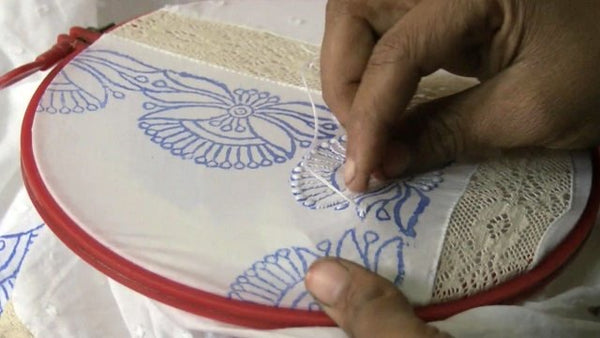
Himanshi Singh watched helplessly as Kamla, a master artisan with 25 years of leatherwork experience, was forced to walk barefoot back to her village a few years ago during the pandemic.
Kamla had spent decades perfecting her craft, but now she had nothing – no income, support, or future.
“If someone like Kamla can lose everything, what chance do others have?” Himanshi asked herself then. Kamla had returned from Delhi to her village, Achrol, in Rajasthan. This question inspired Himanshi to build Bare Craft, a platform that uses AI as a tool and a lifeline for artisans like Kamla.
Over 5,500 verified artisans are on the Bare Craft platform, each rooted in traditional crafts like block printing, Chikankari embroidery, and Kantha work. “We wanted to solve problems like transparency in supply chains, fair wages, and sustainable production,” Himanshi explains.
The platform’s AI matches the right artisans with suitable projects, making it easier for small and medium enterprises (SMEs) to source high-quality crafts. Himanshi, the founding member, works pro bono to support the platform’s growth and market connections, while her mother, Kiran Singh, oversees its operations with the artisan communities. This arrangement allows Himanshi to continue her professional work with other nonprofits.
AI Meets Artisans
One such artisan is Monu Saini, a block printing artisan based near Achrol in Rajasthan, who has dedicated over a decade to his craft. Through the Bare Craft initiative, Monu refined his skills and trained 25 women in block printing, empowering them to pursue financial independence.
“Hand block printing doesn’t involve any chemicals and is good for the environment,” Monu says. His passion for sustainability and community-building has allowed him to collaborate with international designers. Recently, he began working with US-based designers to blend traditional techniques with modern designs. “Through Bare Craft, I’ve connected with small retailers and individual buyers,” Monu says. “This has helped me broaden the reach of my creations while preserving the rich heritage of block printing.”
Bare Craft’s AI system has shown impressive results. “We’ve seen a 10% increase in revenue for artisans and SMEs, with a 50% reduction in production costs,” says Himanshi.
AI might seem an unlikely ally for traditional artisans, but it’s the engine driving Bare Craft. “It’s not just a catalogue,” Himanshi says. “AI helps us recommend raw materials, cuts down on production time, and ensures that artisans get paid fairly, all while minimising costs for buyers.”
One of the platform’s first successes was a designer dress that combined block printing, chikankari embroidery, and kantha work – three distinct crafts, each completed by artisans in different cities. The final product directly supported six artisans.
“We’ve empowered over 150 artisans with training, helping them adapt to a changing market,” Himanshi says. Additionally, 82% of the artisans on the platform have successfully connected to new markets, and 23 have launched independent businesses.
And it’s not just fashion. Bare Craft is helping artisans turn waste into treasure, like converting hosiery waste into cotton stationery, a completely sustainable solution. An example is when an SME buyer started looking at textile waste as a raw material to produce their products – an option not easily available earlier. The system removed the pressure of visiting different sites, sorting the waste, and making it ready to use.
Scaling Art
Bare Craft plans to scale its artisan training program to reach 1,00,000 artisans and achieve a 99% market linkage rate. “We’re also expanding to connect 100 SMEs with artisans to create more collaborations that benefit both sides,” Himanshi says. Her AI application also optimises raw material selection and streamlines logistics, ensuring that every step of the process, from production to delivery, is smooth and cost-effective.
Looking ahead, Bare Craft plans to introduce digital passports for products. This will help buyers see the entire journey of their purchase, from raw material to finished product.”This isn’t just about selling crafts, it’s about making people understand the impact of their purchase,” Himanshi says.
(The author is AI Editor, NDTV)
Disclaimer: These are the personal opinions of the author
This post was originally published on this site be sure to check out more of their content







